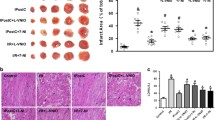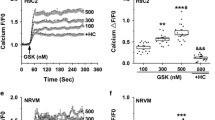Abstract
Hypoxic preconditioning (HPC) protects rat hearts against ischemia–reperfusion (IR) injury. However, the role of transient receptor potential vanilloid 1 (TRPV1) in HPC-mediated cardioprotection remains unknown. TRPV1 is activated by endovanilloid 12(S)-hydroxyeicosatetraenoic acid [12(S)-HETE], which is synthesized by arachidonate 12-lipoxygenase (ALOX12). Therefore, we examined whether HPC protects the myocardium against IR via the ALOX12/TRPV1 pathway. Compared to hearts of rats kept in room air, the hearts of rats kept in air with 10 % oxygen for 4 weeks had better post-ischemic recovery and less tissue damage when subjected to 30-min global ischemia and 4-h reflow in a Langendorff apparatus. Capsazepine, a specific TRPV1 blocker, administered 5 min before reperfusion markedly attenuated the effects of HPC, confirming that TRPV1 is a downstream effector in HPC-mediated cardioprotection. HPC resulted in the upregulation of ALOX12 and myocardial 12(S)-HETE, and prevented IR-induced 12(S)-HETE reduction. In addition, sarcolemmal ALOX12 expression in HPC hearts mainly co-localized with TRPV1 expression. Blockade of ALOX12 by cinnamyl-3,4-dihydroxy-α-cyanocinnamate or baicalein abrogated the effects of HPC, baicalein also decreased 12(S)-HETE expression. Mimicking HPC by given 12(S)-HETE or capsaicin to baicalien-treated hearts enhanced cardiac recovery during reperfusion. The cardiac protein kinase C (PKC) isoforms α, δ, ε, and ζ were preferentially expressed in the sarcolemmal membrane of HPC-treated hearts, indicating their high intrinsic activation state. Capsazepine or co-treatment with baicalein attenuated translocation of PKCα, PKCδ and PKCε, but not that of PKCζ. We conclude that HPC reduces heart susceptibly to IR via ALOX12/TRPV1/PKC pathway, as shown by increased 12(S)-HETE expression in HPC hearts.








Similar content being viewed by others
References
Albert C, Ford D (1999) Protein kinase C translocation and PKC dependent protein phosphorylation during myocardial ischemia. Am J Physiol 276:H642–H650
Armstrong SC (2004) Protein kinase activation and myocardial ischemia/reperfusion injury. Cardiovasc Res 61:427–436. doi:10.1016/j.cardiores.2003.12.023
Bernaudin M, Tang Y, Reilly M, Petit E, Sharp FR (2002) Brain genomic response following hypoxia and re-oxygenation in the neonatal rat. Identification of genes that might contribute to hypoxia-induced ischemic tolerance. J Biol Chem 277:39728–39738. doi:10.1074/jbc.M204619200
Braun MU, LaRosée P, Schön S, Borst MM, Strasser RH (2002) Differential regulation of cardiac protein kinase C isozyme expression after aortic banding in rat. Cardiovasc Res 56:52–63. doi:10.1016/S0008-6363(02)00511-4
Bucciarelli LG, Kaneko M, Ananthakrishnan R, Harja E, Lee LK, Hwang YC, Lerner S, Bakr S, Li Q, Lu Y, Song F, Qu W, Gomez T, Zou YS, Yan SF, Schmidt AM, Ramasamy R (2006) Receptor for advanced-glycation end products: key modulator of myocardial ischemic injury. Circulation 113:1226–1234. doi:10.1161/CIRCULATIONAHA.105.575993
Chen W, Glasgow W, Murphy E, Steenbergen C (1999) Lipoxygenase metabolism of arachidonic acid in ischemic preconditioning and PKC-induced protection in heart. Am J Physiol 276:H2094–H2101
Chu CJ, Huang SM, De Petrocellis L, Bisogno T, Ewing SA, Miller JD, Zipkin RE, Daddario N, Appendino G, Di Marzo V, Walker JM (2003) N-oleoyldopamine, a novel endogenous capsaicin-like lipid that produces hyperalgesia. J Biol Chem 278:13633–13639. doi:10.1074/jbc.M211231200
Ezquer M, Seltzer AM (2003) c-fos and tyrosine hydroxylase expression after an excitotoxic lesion on the nigrostriatal system: a study on the effects of hypoxia used as a preconditioning stimulus. Exp Neurol 183:523–531. doi:10.1016/S0014-4886(03)00247-4
Forkel J, Chen X, Wandinger S, Keser F, Duschin A, Schwanke U, Frede S, Massoudy P, Schulz R, Jakob H, Heusch G (2004) Responses of chronically hypoxic rat hearts to ischemia: KATP channel blockade does not abolish increased RV tolerance to ischemia. Am J Physiol Heart Circ Physiol 286:H545–H551. doi:10.1152/ajpheart.00022.2003
Goldberg M, Zhang HL, Steinberg SF (1997) Hypoxia alters the subcellular distribution of protein kinase C isoforms in neonatal rat ventricular myocytes. J Clin Invest 99:55–61. doi:10.1172/JCI119133
Gross ER, Hsu AK, Gross GJ (2004) Acute aspirin treatment abolishes, whereas acute ibuprofen treatment enhances morphine-induced cardioprotection: role of 12-lipoxygenase. J Pharmacol Exp Ther 310:185–191. doi:10.1124/jpet.103.064667
Hammarberg T, Provost P, Persson B, Rådmark O (2000) The N-terminal domain of 5-lipoxygenase binds calcium and mediates calcium stimulation of enzyme activity. J Biol Chem 275:38787–38793. doi:10.1074/jbc.M006136200
Hughes H, Gentry DL, McGuire GM, Taylor AA (1991) Gas chromatographic-mass spectrometric analysis of lipoxygenase products in post-ischemic rabbit myocardium. Prostaglandins Leukot Essent Fatty Acids 42:225–231. doi:10.1016/0952-3278(91)90087-L
Hwang SW, Cho H, Kwak J, Lee SY, Kang CJ, Jung J, Cho S, Min KH, Suh YG, Kim D, Oh U (2000) Direct activation of capsaicin receptors by products of lipoxygenases: endogenous capsaicin-like substances. Proc Natl Acad Sci USA 97:6155–6160. doi:10.1073/pnas.97.11.6155
Inagaki K, Churchill E, Mochly-Rosen D (2006) Epsilon protein kinase C as a potential therapeutic target for the ischemic heart. Cardiovasc Res 70:222–230. doi:10.1016/j.cardiores.2006.02.015
Källner G, Franco-Cereceda A (1998) Aggravation of myocardial infarction in the porcine heart by capsaicin-induced depletion of calcitonin gene-related peptide (CGRP). J Cardiovasc Pharmacol 32:500–504
Kallner G, Franco-Cereceda A (1998) Ion channels involved in the release of calcitonin gene-related peptide by low pH, prostacyclin and capsaicin in the isolated guinea-pig heart. Eur J Pharmacol 352:223–228. doi:10.1016/S0014-2999(98)00348-3
Kang SW, Natarajan R, Shahed A, Nast CC, LaPage J, Mundel P, Kashtan C, Adler SG (2003) Role of 12-lipoxygenase in the stimulation of p38 mitogen-activated protein kinase and collagen alpha5(IV) in experimental diabetic nephropathy and in glucose-stimulated podocytes. J Am Soc Nephrol 14:3178–3187. doi:10.1097/01.ASN.0000099702.16315.DE
Kuzuya T, Hoshida S, Kim Y, Oe H, Hori M, Kamada T, Tada M (1993) Free radical generation coupled with arachidonate lipoxygenase reaction relates to reoxygenation induced myocardial cell injury. Cardiovasc Res 27:1056–1060. doi:10.1093/cvr/27.6.1056
Kuzuya T, Hoshida S, Yamashita N, Fuji H, Oe H, Hori M, Kamada T, Tada M (1993) Delayed effects of sublethal ischemia on the acquisition of tolerance to ischemia. Circ Res 72:1293–1299. doi:10.1161/01.RES.72.6.1293
Lin JS, Chen YS, Chiang HS, Ma MC (2008) Hypoxic preconditioning protects rat hearts against ischemia/reperfusion injury: role of erythropoietin on progenitor cell mobilization. J Physiol 586:5757–5770. doi:10.1113/jphysiol.2008.160887
Lu MJ, Chen YS, Huang HS, Ma MC (2012) Erythropoietin alleviates post-ischemic injury of rat hearts by attenuating nitrosative stress. Life Sci 90:776–784. doi:10.1016/j.lfs.2012.04.012
McCluskey ER, Murphree S, Saffitz JE, Morrison AR, Needleman P (1985) Temporal changes in 12-HETE formation in two models of canine myocardial infarction. Prostaglandins 29:387–403
Mitchell MB, Meng X, Ao L, Brown JM, Harken AH, Banerjee A (1995) Preconditioning of isolated rat heart is mediated by protein kinase C. Circ Res 76:73–81. doi:10.1161/01.RES.76.1.73
Murphy E, Glasgow W, Fralix T, Steenbergen C (1995) Role of lipoxygenase metabolites in ischemic preconditioning. Circ Res 76:457–467. doi:10.1161/01.RES.76.3.457
Németh J1, Szilvássy Z, Oroszi G, Pórszász R, Jakab B, Szolcsányi J (2001) Impaired capsaicin-induced decrease in heart rate and coronary flow in isolated heart of diabetic rats. Acta Physiol Hung 88:207–218. doi: 10.1556/APhysiol.88.2001.3-4.3
Pan HL, Chen SR (2004) Sensing tissue ischemia: another new function for capsaicin receptors? Circulation 110:1826–1831. doi:10.1161/01.CIR.0000142618.20278.7A
Patel HH, Fryer RM, Gross ER, Bundey RA, Hsu AK, Isbell M, Eusebi LO, Jensen RV, Gullans SR, Insel PA, Nithipatikom K, Gross GJ (2003) 12-lipoxygenase in opioid-induced delayed cardioprotection: gene array, mass spectrometric, and pharmacological analyses. Circ Res 92:676–682. doi:10.1161/01.RES.0000065167.52922.F6
Peng PH, Huang HS, Lee YJ, Chen YS, Ma MC (2009) Novel role for the delta-opioid receptor in hypoxic preconditioning in rat retinas. J Neurochem 108:741–754. doi:10.1111/j.1471-4159.2008.05807.x
Prekumar LS, Aherm GP (2000) Induction of vanolloid receptor channel activity by protein kinase C. Nature 408:985–990. doi:10.1038/35050121
Rafiee P, Shi Y, Kong X, Pritchard KA Jr, Tweddell JS, Litwin SB, Mussatto K, Jaquiss RD, Su J, Baker JE (2002) Activation of protein kinases in chronically hypoxic infant human and rabbit hearts: role in cardioprotection. Circulation 106:239–245. doi:10.1161/01.CIR.0000022018.68965.6D
Rathee PK, Distler C, Obreja O, Neuhuber W, Wang GK, Wang SY, Nau C, Kress M (2002) PKA/AKAP/VR-1 module: a common link of Gs-mediated signaling to thermal hyperalgesia. J Neurosci 22:4740–4745
Ristoiu V, Shibasaki K, Uchida K, Zhou Y, Ton BH, Flonta ML, Tominaga M (2011) Hypoxia-induced sensitization of transient receptor potential vanilloid 1 involves activation of hypoxia-inducible factor-1 alpha and PKC. Pain 152:936–945. doi:10.1016/j.pain.2011.02.024
Rouet-Benzineb P, Mohammadi K, Pérennec J, Poyard M, H Bouanani Nel, Crozatier B (1996) Protein kinase C isoform expression in normal and failing rabbit hearts. Circ Res 79:153–161. doi:10.1161/01.RES.79.2.153
Sexton A, McDonald M, Cayla C, Thiemermann C, Ahluwalia A (2007) 12-Lipoxygenase-derived eicosanoids protect against myocardial ischemia/reperfusion injury via activation of neuronal TRPV1. FASEB J 21:2695–2703. doi:10.1096/fj.06-7828com
Strasser RH, Simonis G, Schön SP, Braun MU, Ihl-Vahl R, Weinbrenner C, Marquetant R, Kübler W (1999) Two distinct mechanisms mediate a differential regulation of protein kinase C isozymes in acute and prolonged myocardial ischemia. Circ Res 85:77–87. doi:10.1161/01.RES.85.1.77
Strecker T, Messlinger K, Weyand M, Reeh PW (2005) Role of different proton-sensitive channels in releasing calcitonin gene-related peptide from isolated hearts of mutant mice. Cardiovasc Res 65:405–410. doi:10.1016/j.cardiores.2004.10.013
Tsutsumi YM, Patel HH, Lai NC, Takahashi T, Head BP, Roth DM (2006) Isoflurane produces sustained cardiac protection after ischemia-reperfusion injury in mice. Anesthesiology 104:495–502. doi:10.1097/00000542-200603000-00017
Vahlhaus C, Schulz R, Post H, Onallah R, Heusch G (1996) No prevention of ischemic preconditioning by the protein kinase C inhibitor staurosporine in swine. Circ Res 79:407–414. doi:10.1161/01.RES.79.3.407
Wang L, Wang DH (2005) TRPV1 gene knockout impairs postischemic recovery in isolated perfused heart in mice. Circulation 112:3617–3623. doi:10.1161/CIRCULATIONAHA.105.556274
Yellon DM, Baxter GF (2000) Protecting the ischaemic and reperfused myocardium in acute myocardial infarction: distant dream or near reality? Heart 83:381–387. doi:10.1136/heart.83.4.381
Zahner MR, Li DP, Chen SR, Pan HL (2003) Cardiac vanilloid receptor 1-expressing afferent nerves and their role in the cardiogenic sympathetic reflex in rats. J Physiol 551:515–523. doi:10.1113/jphysiol.2003.048207
Zhong B, Wang DH (2008) N-oleoyldopamine, a novel endogenous capsaicin-like lipid, protects the heart against ischemia-reperfusion injury via activation of TRPV1. Am J Physiol Heart Circ Physiol 295:H728–H735. doi:10.1152/ajpheart.00022.2008
Zhong B, Wang DH (2007) TRPV1 gene knockout impairs preconditioning protection against myocardial injury in isolated perfused hearts in mice. Am J Physiol Heart Circ Physiol 293:H1791–H1798. doi:10.1152/ajpheart.00169.2007
Acknowledgments
This study was supported by the Shin Kong Wu Ho-Su Memorial Hospital (99SKH-FJU-09, 100SKH-FJU-01) and the National Science Council (101-2314-B-030-002-MY3).
Conflict of interest
On behalf of all authors, the corresponding author states that there is no conflict of interest.
Author information
Authors and Affiliations
Corresponding author
Additional information
M. J. Lu and Y. S. Chen equally contributed in this work.
Rights and permissions
About this article
Cite this article
Lu, MJ., Chen, YS., Huang, HS. et al. Hypoxic preconditioning protects rat hearts against ischemia–reperfusion injury via the arachidonate12-lipoxygenase/transient receptor potential vanilloid 1 pathway. Basic Res Cardiol 109, 414 (2014). https://doi.org/10.1007/s00395-014-0414-0
Received:
Revised:
Accepted:
Published:
DOI: https://doi.org/10.1007/s00395-014-0414-0




